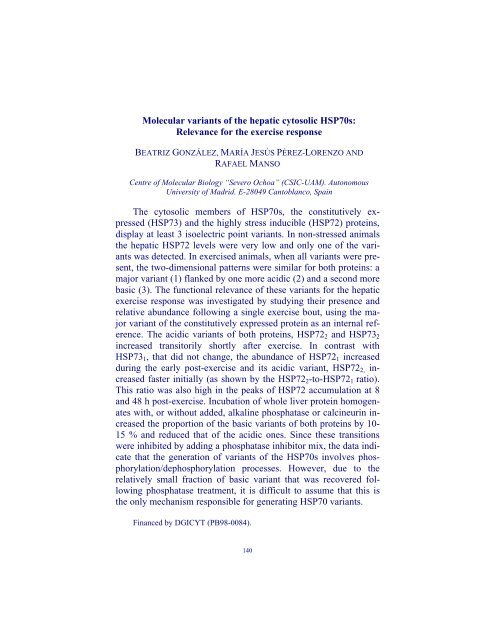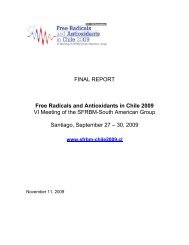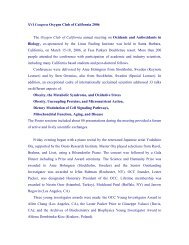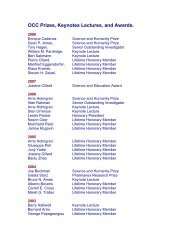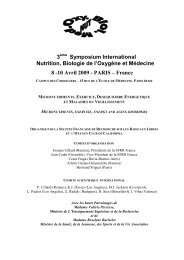oxidants and antioxidants in biology - Oxygen Club of California
oxidants and antioxidants in biology - Oxygen Club of California
oxidants and antioxidants in biology - Oxygen Club of California
You also want an ePaper? Increase the reach of your titles
YUMPU automatically turns print PDFs into web optimized ePapers that Google loves.
Molecular variants <strong>of</strong> the hepatic cytosolic HSP70s:<br />
Relevance for the exercise response<br />
BEATRIZ GONZÁLEZ, MARÍA JESÚS PÉREZ-LORENZO AND<br />
RAFAEL MANSO<br />
Centre <strong>of</strong> Molecular Biology “Severo Ochoa” (CSIC-UAM). Autonomous<br />
University <strong>of</strong> Madrid. E-28049 Cantoblanco, Spa<strong>in</strong><br />
The cytosolic members <strong>of</strong> HSP70s, the constitutively expressed<br />
(HSP73) <strong>and</strong> the highly stress <strong>in</strong>ducible (HSP72) prote<strong>in</strong>s,<br />
display at least 3 isoelectric po<strong>in</strong>t variants. In non-stressed animals<br />
the hepatic HSP72 levels were very low <strong>and</strong> only one <strong>of</strong> the variants<br />
was detected. In exercised animals, when all variants were present,<br />
the two-dimensional patterns were similar for both prote<strong>in</strong>s: a<br />
major variant (1) flanked by one more acidic (2) <strong>and</strong> a second more<br />
basic (3). The functional relevance <strong>of</strong> these variants for the hepatic<br />
exercise response was <strong>in</strong>vestigated by study<strong>in</strong>g their presence <strong>and</strong><br />
relative abundance follow<strong>in</strong>g a s<strong>in</strong>gle exercise bout, us<strong>in</strong>g the major<br />
variant <strong>of</strong> the constitutively expressed prote<strong>in</strong> as an <strong>in</strong>ternal reference.<br />
The acidic variants <strong>of</strong> both prote<strong>in</strong>s, HSP72 2 <strong>and</strong> HSP73 2<br />
<strong>in</strong>creased transitorily shortly after exercise. In contrast with<br />
HSP73 1 , that did not change, the abundance <strong>of</strong> HSP72 1 <strong>in</strong>creased<br />
dur<strong>in</strong>g the early post-exercise <strong>and</strong> its acidic variant, HSP72 2, <strong>in</strong>creased<br />
faster <strong>in</strong>itially (as shown by the HSP72 2 -to-HSP72 1 ratio).<br />
This ratio was also high <strong>in</strong> the peaks <strong>of</strong> HSP72 accumulation at 8<br />
<strong>and</strong> 48 h post-exercise. Incubation <strong>of</strong> whole liver prote<strong>in</strong> homogenates<br />
with, or without added, alkal<strong>in</strong>e phosphatase or calc<strong>in</strong>eur<strong>in</strong> <strong>in</strong>creased<br />
the proportion <strong>of</strong> the basic variants <strong>of</strong> both prote<strong>in</strong>s by 10-<br />
15 % <strong>and</strong> reduced that <strong>of</strong> the acidic ones. S<strong>in</strong>ce these transitions<br />
were <strong>in</strong>hibited by add<strong>in</strong>g a phosphatase <strong>in</strong>hibitor mix, the data <strong>in</strong>dicate<br />
that the generation <strong>of</strong> variants <strong>of</strong> the HSP70s <strong>in</strong>volves phosphorylation/dephosphorylation<br />
processes. However, due to the<br />
relatively small fraction <strong>of</strong> basic variant that was recovered follow<strong>in</strong>g<br />
phosphatase treatment, it is difficult to assume that this is<br />
the only mechanism responsible for generat<strong>in</strong>g HSP70 variants.<br />
F<strong>in</strong>anced by DGICYT (PB98-0084).<br />
140


